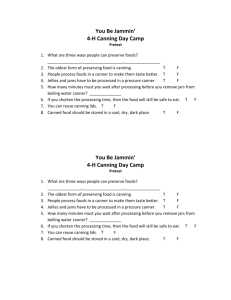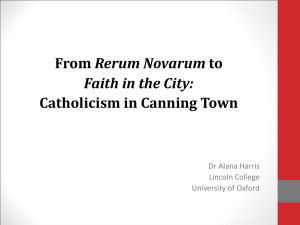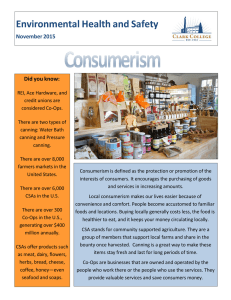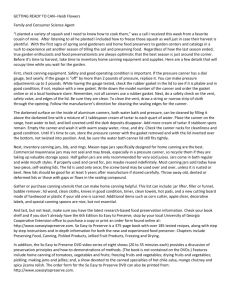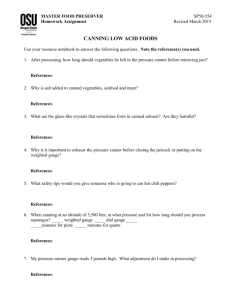Canning Part 2
advertisement
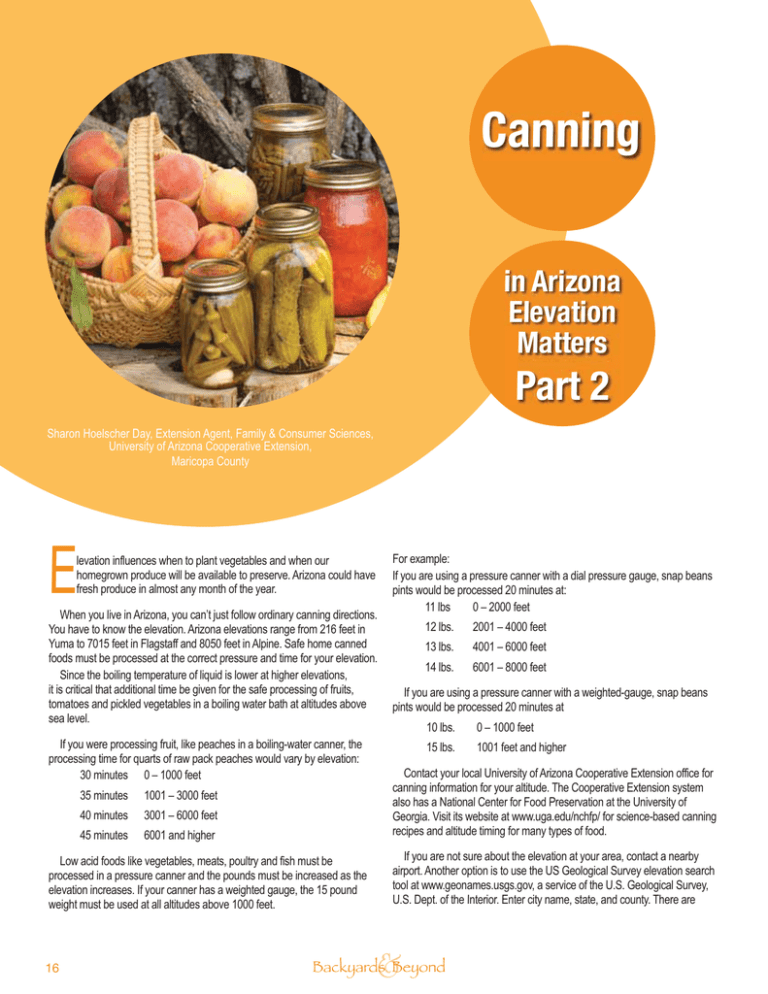
Canning in Arizona Elevation Matters Part 2 Sharon Hoelscher Day, Extension Agent, Family & Consumer Sciences, University of Arizona Cooperative Extension, Maricopa County E levation influences when to plant vegetables and when our homegrown produce will be available to preserve. Arizona could have fresh produce in almost any month of the year. When you live in Arizona, you can’t just follow ordinary canning directions. You have to know the elevation. Arizona elevations range from 216 feet in Yuma to 7015 feet in Flagstaff and 8050 feet in Alpine. Safe home canned foods must be processed at the correct pressure and time for your elevation. Since the boiling temperature of liquid is lower at higher elevations, it is critical that additional time be given for the safe processing of fruits, tomatoes and pickled vegetables in a boiling water bath at altitudes above sea level. If you were processing fruit, like peaches in a boiling-water canner, the processing time for quarts of raw pack peaches would vary by elevation: 30 minutes 0 – 1000 feet 35 minutes 1001 – 3000 feet 40 minutes 3001 – 6000 feet 45 minutes 6001 and higher Low acid foods like vegetables, meats, poultry and fish must be processed in a pressure canner and the pounds must be increased as the elevation increases. If your canner has a weighted gauge, the 15 pound weight must be used at all altitudes above 1000 feet. 16 For example: If you are using a pressure canner with a dial pressure gauge, snap beans pints would be processed 20 minutes at: 11 lbs 0 – 2000 feet 12 lbs. 2001 – 4000 feet 13 lbs. 4001 – 6000 feet 14 lbs. 6001 – 8000 feet If you are using a pressure canner with a weighted-gauge, snap beans pints would be processed 20 minutes at 10 lbs. 0 – 1000 feet 15 lbs. 1001 feet and higher Contact your local University of Arizona Cooperative Extension office for canning information for your altitude. The Cooperative Extension system also has a National Center for Food Preservation at the University of Georgia. Visit its website at www.uga.edu/nchfp/ for science-based canning recipes and altitude timing for many types of food. If you are not sure about the elevation at your area, contact a nearby airport. Another option is to use the US Geological Survey elevation search tool at www.geonames.usgs.gov, a service of the U.S. Geological Survey, U.S. Dept. of the Interior. Enter city name, state, and county. There are & Backyards Beyond at higher elevations by adding 1 additional minute per 1,000 ft above sea level. multiple listings for a county provided. On the entry page, you can also select a feature such as “schools” or “churches” to see listings closest to your home. It is possible to can bread or cake in a jar? Here are just a few elevations in Arizona: Alpine - 8050 feet Mesa - 1248 feet Bisbee - 4780 feet Payson - 5157 feet Casa Grande - 1464 feet Phoenix -1135 feet Chandler - 1243 feet Prescott Valley - 4800 feet Chinle - 5515 feet Safford - 3000 feet Coolidge - 1574 feet Sedona - 4830 feet Eagar - 7080 feet Show Low - 6415 feet Flagstaff - 7015 feet Tombstone - 4743 feet Glendale - 1071 feet Tucson - 2643 feet Kayenta - 5710 feet Window Rock - 6742 feet Kingman - 3449 feet Yuma - 216 feet These products are not recommended for canning; choose recipes that you can freeze. In fact, most of these products are not really “canned.” The directions call for baking in the jar and then closing with a canning lid. Many recipes for quick breads and cakes are low acid and have the potential for supporting the growth of bacteria like Clostridium botulinum if it is present inside the closed jar. One university’s research showed a high potential for problems. You will see these products made commercially; however, additives, preservatives and processing controls not available for home recipes are used. Canning jar manufacturers also don’t endorse baking in their canning jars. SOURCES: USDA Complete Guide to Home Canning, National Center for Food Reservation, University of Georgia Visit our website at cals.arizona.edu/maricopa/fcs/ for information about all of our programs and more information about specific areas. Call our Master Consumer Advisors at our consumer information line, 602-470-8086 Ext. 341 for information on food safety, food preservation, water treatment, foods, home care and other topics. Source: www.airport-data.com/states/Arizona-3.html Visit our website at cals.arizona.edu/maricopa/fcs/foodpres.htm for recipes and information on preserving foods and a link to the National Extension Food Preservation website which includes freezing, canning recipes. Here are some of the frequently asked questions we get at the University of Arizona Cooperative Extension. My mother only used paraffin to seal jellies. Why can’t I do that too? Doesn’t the sugar preserve it? Tetrha Tynaro Even though sugar helps preserve jellies and jams, molds can grow on the surface of these products. Research now indicates that the mold, which people usually scrape off the surface of jellies, may not be as harmless as it seems. Mycotoxins have been found in some jars of jelly having surface mold growth. Mycotoxins are known to cause cancer in animals, but their effects on humans are still being researched. Because of possible mold contamination, paraffin or wax seals are no longer recommended for any sweet spread, including jellies. When you process jellies and jams in a boiling water bath, it also extends its storage life. To prevent growth of molds and loss of good flavor or color, fill products hot into sterile canning jars, leaving 1/4-inch headspace, seal with self-sealing lids, and process 5 minutes in a boiling-water canner. Correct process time Fall Fallll2008 Fa 2008 200 008 Fall 17 17 17 17
